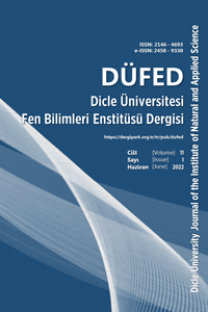Dünya Tahıl Üretim ve Veriminin Karbon Dioksit Emisyonu Üzerine Etkisini İnceleyen İstatistiksel Bir Araştırma
Tahıl verim, Tahıl üretim, Karbon dioksit emisyonu, İklim değişikliği
A Statistical Study Examining the Effect of World Grain Production and Yield on Carbon Dioxide Emissions
Grain yield, Grain production, Carbon dioxide emission, Climate change,
___
- G. Akın, “Küresel ısınma, nedenleri ve sonuçları’’, Ankara Üniversitesi Dil Ve Tarih-Coğrafya Fakültesi Dergisi, vol. 46, no. 2, pp. 29-43, 2006.
- J. Bellarby, B. Foereid, A. Hastings, P. Smith, Cool farming: climate impacts of agriculture and mitigation potential. Greenpeace International, Amsterdam, The Netherlands, 2008.
- FAO. World food and agriculture – Statistical Yearbook, Rome, 2021.
- Z. Koday. “Türkiye'nin tahıl üretimi’’, Türk Coğrafya Dergisi, vol. 35, pp. 299-320, 2014. Retrieved from https://dergipark.org.tr/en/pub/tcd/issue/21252/228015
- A. Muller, C. Aubert, The potential of organic agriculture to mitigate the ınfluence of agriculture on global warming. a review, S. Bellon, S. Penvern Eds, Organic Farming, Prototype for Sustainable Agricultures.. 2014. DOI 10.1007/978-94-007-7927-3_13
- P. K. Narayan, S. Popp, “A new unit root test with two structural breaks in level and slope at unknown time’’, Journal of Applied Statistics, vol. 37, no. 9, pp. 1425-1438, 2010.
- W. Enders, J. Lee, Oxford Bulletin of Economics and Statistics, vol. 74, no. 4, pp. 574-599, 2012.
- J. L. Carrion-i-Silvestre, A. Sanso, “Testing the null of cointegration with structural breaks. Oxford’’, Bulletin of Economics and Statistics, vol. 68, no. 5, pp. 623-646, 2006.
- A. W. Gregory, B. E. Hansen, “Practıtıoners Corner: Tests for Cointegration in Models with Regime and Trend Shifts’’, Oxford Bulletin of Economics and Statistics, vol. 58, pp. 555-560, 1996. https://doi.org/10.1111/j.1468-0084.1996.mp58003008.x
- Y. Arai, E. Kurozumi, “Testing for the null hypothesis of cointegration with a structural break’’, Econometric Review, vol. 2, pp. 705-739, 2007.
- M. L. Tseng, K. H. Tan, “ Sustainable consumption and production in emerging markets’’, International Journal of Production Economics, vol. 181, pp. 257-261, 2016.
- H. Y. Toda, T. Yamamoto, “ Statistical inference in vector autoregressions with possibly integrated processes’’, Journal of Econometrics, vol. 66, pp. 225–250, 1995.
- ISSN: 2146-4693
- Yayın Aralığı: Yılda 2 Sayı
- Başlangıç: 2012
- Yayıncı: Dicle Üniversitesi
Ekmeklik Buğday İleri Hatlarının Verim ve Verim Kriterlerinin İncelenmesi
Önder ALBAYRAK, Merve BAYHAN, Remzi ÖZKAN, Cuma AKINCI
Atıksu Arıtma Tesisinin Model Tabanlı Optimizasyonu: Hakkari Örnek Çalışması
Mardin İli Sınırlarından Toplanan Yerel Makarnalık Buğday Popülasyonlarının Karakterizasyonu
Yem Bezelyesinin Çimlenme Döneminde Çinko ve Bor Gübrelerine Tepkileri
Negar EBRAHIM POUR MOKHTARI, Ferhat KIZILGEÇİ
Önemli Bir Arpa Patojeni: Ramularia collo-cygni
Zeynep ASLAN, Arzu ÇELİK OĞUZ, Aziz KARAKAYA
Üretici Birliklerinin Örgütlenme Bilincine Katkıları: Telli Terbiye Sistemli Bağcılık Örneği
İrem DUZDAR ARGUN, Gülşah OCAKLI
